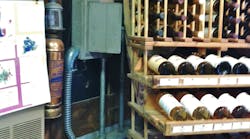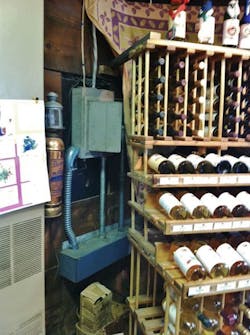How well do you know the Code? Think you can spot violations the original installer either ignored or couldn't identify? Here's your chance to moonlight as an electrical inspector and second-guess someone else's work from the safety of your living room or office. It's your turn to identify the violation.
Hint: A vineyard violation
Find the Answer
I spotted this work space violation while my wife and I were enjoying a day trip to a winery and vineyard. The shop owners obviously don’t know that the space in front of this panelboard needs to be kept clear so that people can reach the circuit breakers in an emergency, and electricians can work safely around it. While the wine may be delicious, it should not be stored in front of this panelboard.
Section 110.26(B) clearly and concisely states that this space shall not be used for storage. The depth in front of this panelboard should be clear for at least 3 ft, as specified in Table 110.26(A). Section 110.26(A)(2) requires a width of at least 30 in. to be kept clear, and Sec. 110.26(A)(3) requires this space to be clear for a height of at least 6½ ft.
Imagine yourself trying to work in this panelboard with this wine rack in your work space. Now imagine how dangerous it would be trying to troubleshoot or take voltage readings in this panelboard while it was energized! It would be extra dangerous with these obstacles in your way.
Section 240.24(A) also requires overcurrent devices, such as circuit breakers, to be readily accessible, which is definitely not the case here.





